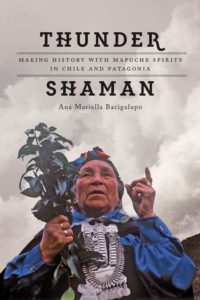Reviewed Book
Thunder Shaman: Making History with Mapuche Spirits in Chile and Patagonia. Ana Mariella Bacigalupo, Austin: University of Texas Press, 2016, 288 pp.

Ana Mariella Bacigalupo’s Thunder Shaman: Making History with Mapuche Spirits in Chile and Patagonia is the creative and scholarly outcome of a friendship between the author and a Mapuche shaman, Francisca Kolipi, whom she served as ritual assistant. Effectively commissioned by Kolipi as a “bible” that would convey the story of her life and be a vehicle of shamanic power, the book exemplifies and discusses the kinds of complex relationships, jointly negotiated projects, and questions of representation that characterize contemporary ethnographic research and decolonializing projects more generally. Kolipi’s aims are balanced quite explicitly in the text against the author’s stated objective of documenting how Mapuche shamans both agentively constitute historical–political events and are constituted by them.
An ethnohistorical and contemporary ethnography, Thunder Shaman chronicles the lives, accomplishments, and community narratives about a single shamanic spirit through two cycles of embodiment in the 19th and 20th centuries. Separate chapters outline the biographies of Francisca Kolipi and her shamanic predecessor, Rosa Kurin, as well as the ways their lives and legacies have been interpreted and reinterpreted over multiple generations in the southern Chilean community of Millali. More than 50 years after Rosa’s death, for example, local mythology turns the insidious savage/civilized dichotomy on its head, memorializing her as a civilized cosmic shaman who protected the community against the savage settler devil.
Bacigalupo describes this mythologization as part of culturally salient cycles of “disremembering and re-remembering” that transform personhood. Disremembering allows the particulars of a shaman’s life to fade from memory such that their spirit can be subsumed into the collective ancestral shamanic spirit before being reborn in a new individual. Shamans themselves use altered states of consciousness to travel to other times, collapsing notions of linear temporality. This allows them to harness myth and resignify the colonial past in making sense of present challenges, symbolically healing the injuries of settler colonialism and the present neoliberal economy. Bacigalupo lays out how these processes relate to local constructions of ethnic identity and efforts to remediate intra– and interethnic conflict.
Throughout the book, Bacigalupo reflects on how her collaborative project took shape over years of conversation, first with Kolipi and later with her descendants. Rooted in decades of fieldwork in the Millali community of southern Chile, the result is a compelling and multi-vocal account that is best read in light of the author’s larger oeuvre, including her earlier ethnographies Shamans of the Foye Tree: Gender, Power, and Healing among the Chilean Mapuche and La Voz del Kultrun en la Modernidad: Tradición y Cambio en la Terapéutica de Siete Machi Mapuche. Among these books, Thunder Shaman is the least focused on issues of health and healing per se, opting instead to explore the role of Mapuche thunder shamans as political actors and moral history-makers. Several features of the book reflect the preferences of Kolipi, her family, and local community leaders. For example, breaking with disciplinary convention, Thunder Shaman eschews pseudonyms in favor of reporting the full names of most of the community members whom Bacigalupo quotes. This authorial decision was made in response to community members’ critiques about anonymization in her earlier publications, which they viewed as taking credit and power away from a speaker. Bacigalupo’s interlocutors emerge in the book not only as named individuals but also as multi-dimensional people who have dynamic opinions and relationships, including with Kolipi and with the author. Bacigalupo takes a decidedly reflexive approach in the book, explaining her positionality vis-à-vis her collaborator and the community as well as reporting on how Kolipi viewed their relationship, fictive kinship, and affinity.
Medical anthropologists may find the book most valuable for its contribution to the scholarship of shamanic personhood and healing practice. But the most remarkable insights of the book concern collective memory, indigenous history-making, and Mapuche cyclical temporality. Should the thunder shaman spirit find embodiment anew in the community of Millali, Bacigalupo’s book may fulfill Kolipi’s intended purpose for it, both testament and powerful ritual object that will help a new shaman to reshape regional history and heal the community from internal rifts and external challenges. In the meantime, this academic text is a must-read for medical anthropologists interested in ethnomedicine and indigenous Latin America. Its sophistication may make it a challenging read for undergraduates, but it would be a good fit for graduate-level medical anthropology courses addressing the aforementioned topics, medical pluralism, or healing in cross-cultural perspective as well as cultural anthropology courses addressing decolonizing methodologies and ethnohistory.